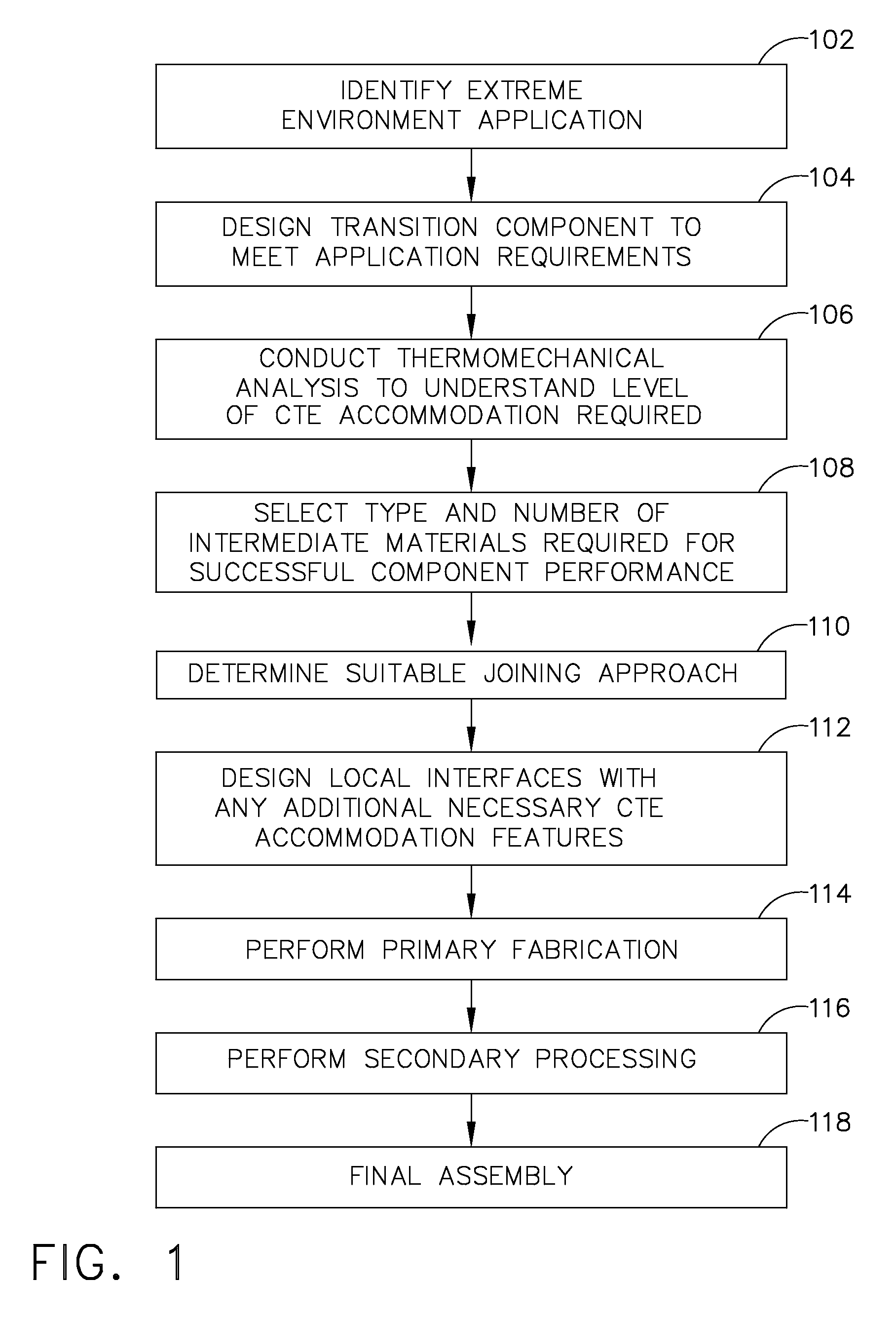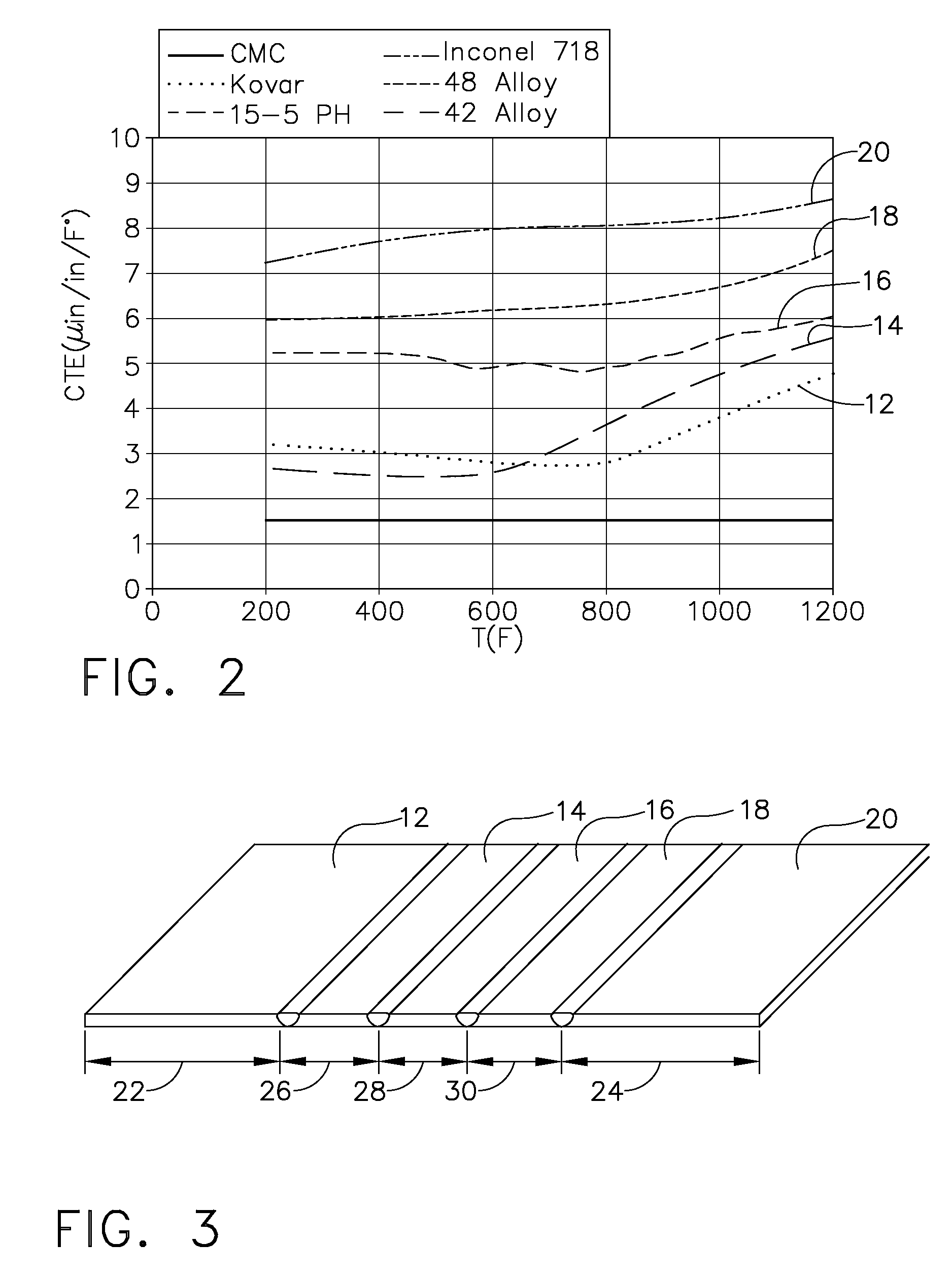Joined composite structures with a graded coefficient of thermal expansion for extreme environment applications
a composite structure and coefficient of thermal expansion technology, applied in the field of composite structures, can solve the problems of increasing design complexity, increasing cost, and difficulty in attaching members with dramatically different coefficients of thermal expansion for use in high and low temperature applications
- Summary
- Abstract
- Description
- Claims
- Application Information
AI Technical Summary
Benefits of technology
Problems solved by technology
Method used
Image
Examples
example 1
[0090]Attachment of a ceramic matrix composite thruster chamber 150 to a titanium injector 152 in a rocket engine assembly as shown in FIG. 14B.
[0091]The most common material of construction of a rocket chamber is a silicide coated Nb alloy. The operating temperature limited to 2500 F (˜50% of combustion temperature) and fuel film cooling is employed to maintain this thermal limit. The use of extensive amounts of fuel film cooling may lead to undesirable results. The key to high performance is the combustion chamber material life limiting mechanisms. Another challenging issue for high performance is providing leak-free joints while attaching a combustion chamber to an injector. The combustion chamber operates at high temperatures while the injector needs to be maintained at low temperatures. Currently, Nb rocket chambers are welded directly to the injectors.
[0092]The use of ceramic matrix composite chambers can enable the design of higher performance rocket engines with reduced plum...
example 2
[0094]An alternative method for attachment of a ceramic matrix composite chamber 150 to a titanium injector 152 in a rocket engine assembly as shown in FIG. 14B is provided by stir welding of the layers for transition component 154.
[0095]FIG. 15A describes the refinement of the generalized method for this example and is described with respect to the illustrations in FIGS. 6A and 6B and 15B. The method shown provides for assessment of the extreme environment application 1502, which for the example shown is the injector-chamber attachment component in a rocket engine with the injector fabricated from titanium and the chamber constructed from CMC. Component design 1504 is then accomplished providing a cylindrical interattchment ring which is to be EB-welded on one side to the titanium injector and brazed on the opposite side to the CMC chamber. A thermomechanical analysis is then undertaken 1506 which demonstrates a maximum temperature at the interface of approximately 1300 F and mecha...
example 3
[0097]Engine-nozzle attachment component 170 in aircraft as shown in FIG. 16B wherein an engine flange (attachment interface) 172 is made from Inconel 718 and a nozzle 174 is CMC.
[0098]Aircraft engines may offer better fuel economy by running the combustor section at higher temperatures. Metallic alloys conventionally used for the exhaust systems may have an undesirably short service life at the higher temperatures. Replacing the current metallic exhaust system with ceramic matrix composites may resolve this issue and may potentially help reduce weight. However, such a ceramic matrix composite exhaust system (very low CTE) should be designed to mate to a superalloy engine interface (very high CTE). Providing a leak-free attachment between the ceramic matrix composite nozzle and a superalloy flange (e.g. made of Inconel 718) is a challenge since they cannot be directly welded and other attachment options are not practical due to the dramatic CTE mismatch. The CTE mismatch can be addr...
PUM
| Property | Measurement | Unit |
|---|---|---|
| thickness | aaaaa | aaaaa |
| temperature | aaaaa | aaaaa |
| coefficient of thermal expansion | aaaaa | aaaaa |
Abstract
Description
Claims
Application Information
 Login to View More
Login to View More - R&D
- Intellectual Property
- Life Sciences
- Materials
- Tech Scout
- Unparalleled Data Quality
- Higher Quality Content
- 60% Fewer Hallucinations
Browse by: Latest US Patents, China's latest patents, Technical Efficacy Thesaurus, Application Domain, Technology Topic, Popular Technical Reports.
© 2025 PatSnap. All rights reserved.Legal|Privacy policy|Modern Slavery Act Transparency Statement|Sitemap|About US| Contact US: help@patsnap.com



